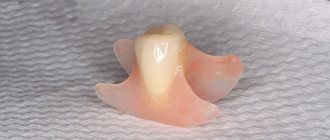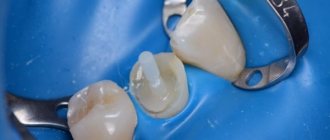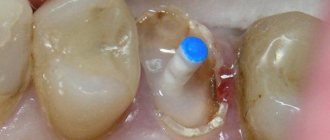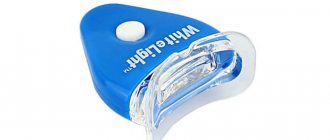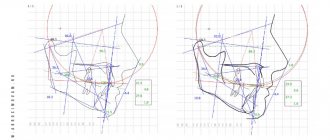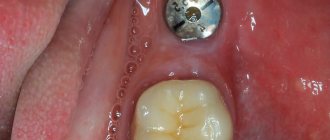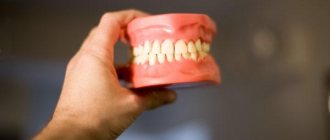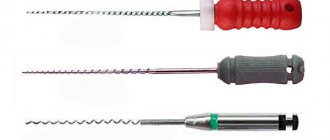What is preparation or grinding of enamel: a complete list of indications for this procedure
Article navigation
- What is preparation
- What preparation is needed before turning?
- Types of turning
- Peculiarities of turning for different types of prostheses
- Types of ledges when fixing crowns
- Features of the procedure in children
- Will it hurt when turning?
- What to do if there is pain after turning
- Is preparation always necessary?
- How much will the turning cost?
Question to a specialist
To restore “problematic” or missing teeth, we go to an orthopedic dentist who offers various prosthetic options. However, the installation of a veneer, crown, removable dentures or bridge is almost always preceded by dental grinding - and the very mention of it immediately frightens patients. What kind of procedure is this, in what situations is it used, will it hurt, what are the features of the preparation and how the process works in patients of different ages - all this is discussed in today’s material.
The main stages of the procedure for installing a dental crown
Installing a crown on a tooth - this procedure is usually divided into several stages, which will be useful to get to know before your initial visit to the dentist. The main stages of the process of placing dental crowns will be discussed in detail below.
First visit to an orthopedic dentist
During the initial appointment, the specialist examines the patient’s oral cavity, prescribing additional tests if necessary. Based on the data obtained, the doctor develops a treatment plan, offering the patient possible options for restoring lost teeth or dentition aesthetics. The treatment plan takes into account not only the need to install a denture, but also additional manipulations, including: Removal of severely damaged and non-viable dental units;
Treatment of the patient’s dental and oral diseases: caries, pulpitis, root canal filling, oral sanitation.
Next, a specific type of dental crown is selected and the cost of turnkey prosthetics is calculated and the timing of its implementation is also determined.
What is preparation
At its core, the preparation process involves removing part of the hard tissue. This layer, represented by enamel (the outer shell) and dentin (these are the internal tissues), must be equal to the thickness of the prosthesis. Armed with a bur, the doctor cuts off the excess and gives the crown the shape on which the prosthesis will easily and reliably fit. It is important to ensure maximum density and absolute accuracy of its fit. As a rule, the shape of a natural tooth is a cone or cylinder.
Relatively speaking, you will have to “cut off” the amount that is equal to the thickness of the prosthesis. For example, zirconium dioxide will require minimal grinding, but metal-ceramics (after all, there are both ceramics and metal) will require the removal of a thicker layer of living tissue.
Preparation is also carried out during filling, but in this case only inflamed tissues are removed, while healthy ones are preserved. If you need to install a prosthesis, even living tissue will have to be removed.
What kind of crowns are placed on teeth?
The following prostheses are used for dental prosthetics with crowns:
- Metal-ceramic is a budget-friendly, strong and durable crown option. The base of the prosthesis is metal, the top lining is ceramic. This ensures its strength and external aesthetics.
- All-ceramic - crowns for the front teeth are made from ceramic, since the material is not suitable for the significant chewing loads that are inherent in the lateral and chewing teeth.
- Zirconium dioxide is a premium material in modern orthopedics, used to restore both anterior and chewing teeth, as it has unsurpassed strength and naturalistic aesthetics today.
What preparation is needed before turning?
In order to secure the future prosthesis well, the prepared crown must be strong, free of plaque and stone, and free of carious lesions (if any, the doctor will, of course, remove them first). Also, before treating the enamel under any prosthesis, it is important to remove soft and hard plaque.
Only until 15.01 South Korean implant Osstem - from 18,500 rubles.
Hurry up to sign up for a free consultation and lock in promotional prices.
Call now or request a call
Opening hours: 24 hours a day - seven days a week
Types of turning
The choice of technique depends mainly on the individual clinical picture, as well as on the volume of tissue that needs to be trimmed. There are types that are more extended in time, and there are very fast, safe and pass without the slightest pain. Let's look at all of them that currently exist. But keep in mind that the choice always remains with the attending physician, who will assess the situation and select the most optimal option.
Ultrasonic
This method involves the use of a special apparatus that produces high-frequency vibrations - ultrasonic. And the device itself is called a “scaler” or “scaler”. By the way, it is used to clean enamel from plaque. Also, instead of a scaler, a piezo device can be used - its action is again based on the use of ultrasonic waves, but they are more powerful, which allows it to be used on harder tissues.
During the procedure, the doctor does not touch the enamel with the instrument. Almost no heating occurs. So the risk of damage disappears. As for pain, it may well occur if there is increased sensitivity, so anesthesia will be appropriate. The method makes it possible to dissect only a small volume.
Laser
This is another effective non-contact turning method. The laser acts on the enamel pulsed, but again removing only a very small layer of enamel and inner dentin. By the way, unlike ultrasound, this method is safer, since laser beams have a wound-healing effect. The method is absolutely silent and allows you to quickly achieve the desired result.
Preparation with a drill
This technology involves the use of a good old drill and a diamond (or metal) tip . In fact, this is the most common and optimal turning option. The doctor can choose different speeds of rotation of the bur, but to prevent overheating, water must be supplied. In fact, the process is no different from drilling in the treatment of caries - everything is done in a similar way.
Watch the video at the end of the article - you can get an idea of how the process of preparing a tooth cavity using a drill occurs.
Air abrasive method
This technique is based on the use of a jet of water and a composition with abrasive particles. Using an air-abrasive method, the doctor is able to smoothly grind off the required amount of tissue. The patient does not feel pain. There is almost no heating and vibration. But the technique makes it possible to remove, again, only a minimal amount of tissue.
Chemical turning method
This method involves using exclusively active acids. Penetrating into tissues, special compounds destroy them. The doctor will only have to remove the softened areas and give the crown the necessary shape so that it fits well under the future prosthesis or structure. The procedure is not quick. The method is considered outdated and is not often used.
On a note! Thus, in 99% of cases it is drilling with a drill that is used for prosthetics (and not for the treatment of superficial caries). It is this technology that allows you to remove any amount of tissue in an extremely short time. True, anesthesia will definitely be required (except for those cases when the tooth is already “dead”, that is, without a nerve).
Features of the event
Before grinding teeth, X-ray diagnostics are performed to clarify their structure, identify possible hidden pathologies and determine places where the thickness of the dental tissues is the smallest, which means there is a possibility of opening the pulp chamber during preparation. If the procedure is performed on living teeth, local anesthesia is performed. On previously pulpless teeth, preparation does not require anesthesia, but many patients still ask for it to be done so as not to experience discomfort.
Today, dentists carry out several types of dental tissue preparation, differing in the tools and technology used:
- Tunnel grinding of teeth . It is carried out using a turbine medical unit (bur) with steel or diamond tips of the working tool. This installation makes it possible to regulate the speed of the procedure, and during preparation the doctor tries to remove as little of his own dental tissue as possible. The main advantage of the method is the ability to fully control the depth of preparation and complete predictability of the result obtained.
- Ultrasonic preparation . The procedure is carried out using high-frequency ultrasonic vibration of the working tool. In this case, the dental tissues do not heat up, the pressure on them is minimal, there are no microcracks or chips in the enamel, and the pulp tissues are not affected in any way.
- Laser preparation . The procedure is carried out using a pulsed laser, under the influence of which the desired layer of enamel and dentin is removed. The procedure is completely safe, silent, atraumatic, and completely eliminates the possibility of infection and the formation of chips and cracks.
- Chemical method . The dental tissue is softened using an active chemical (usually acids) and then removed. There is no heating of dental tissues, chips or microcracks.
- Air abrasive method . An air-powder mixture is used here, which is supplied under high pressure. Abrasive particles of powder remove the desired layer of hard tissue, and tooth dust is immediately removed from the oral cavity.
When choosing a technique, the doctor is usually guided by a number of factors: the clinical situation, the condition of the oral cavity as a whole, the wishes of the patient and the capabilities of the clinic.
Peculiarities of turning for different types of prostheses
The type of prosthesis that the patient and the doctor chose to install also determines the preparation technology. Let's consider the features of preparation for each type.
For veneers and lumineers
High-quality turning for veneers allows you to achieve good contact with the artificial plate. The patient will not then feel the pad in his mouth as something foreign. But here it is important to understand why exactly this procedure is necessary:
- for a good fit of the veneer (we will explain later how exactly the turning is done),
- so that the linings do not “stand out”, that is, so that the teeth are not excessively thick,
- so that the row can be leveled using veneers. For example, you will have to grind off the front part of the enamel if one of the elements is crooked and stands out in front. Of course, one overlay will be slightly thinner than the others. But it also has a limit on the minimum thickness - often in such situations the tooth is simply given a new shape.
When installing veneers, the enamel is ground down by the dentist in a special way. First, the doctor treats only the outer, “front” part, followed by the side and cutting surfaces. Very often, vertical and horizontal recesses are made in the front, which are filled with dental glue. All this significantly improves the fixation strength of the pads.
Don't know what type of prosthetics to choose?
We will help in the selection, advise where to read more information and compare types of prosthetics.
Consultation with an orthopedic doctor in Moscow clinics is free! Call now or request a call
Working hours: from 9:00 to 21:00 - seven days a week
It is interesting that to install, for example, thin veneers made of pressed ceramics or lumineers, such strong grinding is often not necessary (especially if your own teeth are straight). It is enough to simply grind the surface using an air abrasive method or a laser to make it a little rougher. This again will allow the lining to be fixed much better and for a longer period.
Under the tabs
Inlays are prosthetics that replace fillings. They are needed in situations where there are still too few indications for a crown, that is, it is too early to place it. Grinding under an inlay is slightly different from preparing for a filling. In order to install the product well, the doctor will only remove all inflamed (carious) tissue, after which he will carefully process the cavity and take impressions, because the inlay is created in the laboratory.
For crowns
A crown helps restore the integrity and beauty of any tooth, and also protects the fragile pulpless unit from destruction and the risk of caries. When preparing a tooth for a crown, it is important to create a special ledge (their types are listed below) - in fact, the future prosthesis will rest on it. Such ledges are most often located under the gum so that the entire tooth can be completely covered, as well as the transition between the crown and living tissues can be hidden.
Let's consider the features of preparation depending on the material of a single prosthesis:
- for cast metal: grinding starts from the sides, remove up to 0.7 mm,
- like plastic: they are more aesthetically pleasing than metal ones; They can be used to cover both front and side teeth. But here the rules are as follows: a plastic prosthesis is made thicker, especially if a metal base is added. So you will have to grind off quite a lot - more than 1.5 mm,
- for metal ceramics: remove up to 2 mm on each side. Such a prosthesis again consists of a combination of materials, so it turns out to be quite thick,
- under porcelain: the dentist gives the unit being processed a cone-shaped or cylindrical shape. Requirements for the ledge: it is made rounded and goes under the gum by 1 mm. Turning – up to 2 mm on each side. When using pressed ceramics - much less, up to 1 mm,
- for zirconium: it is important to obtain an accurate edge of a rounded or shoulder-shaped ledge. As a rule, it grinds down about 0.5-0.7 mm.
It is important to understand that these indicators are completely average. Everything depends not only on the material as a whole, but also on the specific doctor and laboratory equipment.
Complex on 4 OSSTEM implants with delayed loading - from RUB 170,000.
Complex implantation Osstem (South Korea) with delayed loading after 4-6 months.
Guarantee for the doctor’s work - unlimited Call now or order a call
Opening hours: 24 hours a day - seven days a week
This is interesting! Today, it is very common for metal-ceramic crowns to be created with “shoulder mass.” In terms of thickness, they are no different from ordinary ones, but they have a very big advantage: the outer ceramic coating covers the metal underneath, that is, the metal base does not come into contact with living tissues in any way. This eliminates allergic reactions and does not cause blue gums.
Accordingly, if you plan to install a bridge, then grinding down the supporting teeth will be carried out in the same way as when fixing single crowns. Because the bridge consists of them.
For removable dentures
Often, teeth need to be ground down in order to install removable dentures. But only if a reinforced fixation system is used. For example, clasps that are placed inside the crown part, or telescopic crowns that are fixed on top of living teeth.
When splinting
To prevent the patient's teeth from becoming loose (this also happens with advanced periodontal disease or periodontitis), splinting is used. To secure the splint, the enamel is prepared minimally - for this, a small depression is made on the inside of the entire dentition, inside which a special splinting thread is placed. However, in a number of situations it can be simply secured from above, so turning is not required.
Medical Internet conferences
Basic principles of tooth preparation for metal-ceramic crowns.
In the technology of manufacturing fixed structures, the most critical link is the preparation of the supporting teeth, since the process itself is irreversible, unlike other stages, and making gross errors is unacceptable. Therefore, I believe that geometrically correct preparation of the supporting teeth, as well as careful processing of hard tissues in the area of the edges of the future structure, is a very important factor in ensuring the durability of the structure and its biological compatibility with surrounding tissues.
In general, when preparing abutment teeth, it is necessary to create a retention form of the stump, as well as the proper interocclusal space necessary to accommodate an aesthetically satisfying and load-resistant structure. In this case, it is desirable to avoid excessive grinding of hard tissues and trauma to the marginal periodontium. In some cases, a larger volume of grinding of hard tissues and a subgingival location of the preparation border are possible, justified by aesthetic requirements or to increase retention.
Types of ledges
Professor Martignoni offers a choice of three types of ledges
- Shoulder (covered with ceramics and metal)
- Shoulder with bevel (overlaid with metal)
- Rounded ledge with bevel (shamfer with bevel) (overlaid with metal)
The bevel of the edge of the ledge is necessary in order to achieve a tighter fit of the crown to the tooth. The angular shoulder (50 degrees), which Kuwata proposed, according to Professor Martignoni, must be covered with metal, otherwise it will not be possible to create an accurate outer contour of the crown.
The preparation scheme proposed by Martignoni is as follows.
On the vestibular surface there is a shoulder, on other surfaces there is a shoulder or a rounded ledge with a bevel. The width of the ledge is on average 1.2 mm; on proximal surfaces the width can be reduced to 0.8 mm.
Domenico Massironi suggests creating a ledge in the form of a modified rounded slope (a long rounded slope). This ledge is universal and suitable for any type of crown. The practitioner can control tissue reduction by using half the diameter of the diamond bur to prepare the preparation and by keeping the center of the bur as close to the final preparation line as possible. The angle of the ledge is approximately 60 degrees.
Two-plane preparation.
Picture 1
The theory of two-plane preparation was developed and described in detail by Kuwata, a famous Japanese dental technician. According to his theory, the vestibular surface of all teeth and the palatal (lingual) surface of molars and premolars has 3 planes:
- Cervical (which corresponds to the direction of the root plane)
- The main one (which coincides with the plane of the gum of the alveolar process)
- The plane of the cutting edge (in incisors and canines) or tubercle (in premolars and molars).
When preparing for a crown, it is necessary to take into account 2 planes: the main one and the cutting edge. The cervical plane will be important when creating a crown; ideally, the contour of the crown at the margin should coincide with the cervical plane and the direction of the root. Overcontouring of the crown will lead to chronic inflammation of the gums. Three-plane preparation is performed when processing the vestibular surface of the tooth for veneer.
Advantages of two-plane preparation.
- Sufficient space is created for the manufacture of an aesthetic metal-ceramic crown. This is especially important in the area of the cutting edge of the incisors and canines.
- Tooth tissue is preserved in the area of the middle third of the stump. Excessive tooth preparation is avoided.
- A more retentional shape of the stump is created due to less taper in the lower and middle third, that is, the so-called “retention zone” of the stump is not lost.
Conclusion
Planning the preparation of abutment teeth should be based on the following principles:
- maximum preservation of dental tissues performance of two-plane preparation
- providing conditions for retention of the future structure, creating a minimum angle of occlusal convergence
- compliance of the shape and surface of the prepared tooth with the requirements of a specific restoration manufacturing technology (casting, CAD/CAM milling);
- integrity of marginal periodontal tissues,
- dividing the preparation into 2 stages allows you to correct errors made during primary processing, avoid exposing the final preparation line in individuals with a thin periodontal biotype, and makes it possible to make an individual mini or full tray to obtain a one-stage impression.
Types of ledges when fixing crowns
If you look at the photo below, it will immediately be clear what ledges are - they are needed to fix the crowns. Such ledges are located under the gum so that the border between the tooth and the prosthesis is hidden.
Accordingly, they also come in different shapes:
- knife-shaped: in fact, in such a situation there is no ledge - the top of the tooth will simply have the shape of a cone. Solid metal crowns are fixed in this way (but today this method is rarely used),
- rounded: used for attaching metal-ceramic crowns, but also not used often,
- shoulder: this is the most popular option, and it is also universal. Such a ledge, although large in thickness, is considered the most aesthetic. It has an angle of approximately 90 degrees.
Will it hurt when turning?
The word “grinding” used to sound scary coming from a dentist. Today, the preparation process does not last long and takes place without any discomfort or pain. Before starting the procedure, the doctor will “freeze” the mucous membrane with a special gel, and the patient will not feel the injection with a good local anesthetic at all. Anesthesia is used both in the case of working with living units (in order to “turn off” for a while the nerve that is sensitive to any manipulation) and with “dead” units in which the nerve is absent. After all, turning involves a very painful retraction of the gums.
What to do if there is pain after turning
It happens that after the anesthetic wears off, the patient experiences unpleasant sensations. They can be either a type of norm or a pathology. Teeth hurt after grinding for the following reasons:
- overheating occurred: the bur rotates at a very high speed, so if the doctor performed the procedure quickly, without stopping, tissue overheating could occur. In this case, the pain will be monotonous, but will go away on its own after a few days or weeks, less often - after a couple of months,
- During preparation, too much was removed: the dentin layer has become thin, the nerve is close, so it is completely normal that the tooth will react with pain. But this is no longer the norm - to prevent such situations from occurring, most doctors still suggest depulping before installing a prosthesis,
- the gums are injured: quite often doctors use special threads and metal plates to push back the mucous membrane. Therefore, slight inflammation and swelling of the gums after the procedure is normal, which disappears on its own within a few days.
- errors when grinding: what to do after the procedure for processing units if the painful symptoms do not disappear even after several days? This is a reason to visit the dentist. It is possible that the nerve was injured or the root split, which led to the development of an inflammatory process. In such a situation, the pain will be acute, tissue swelling is possible (and not only the gums, but even the face). This situation requires a prompt solution.
On a note! The important point is that after turning, a temporary prosthesis is almost always installed - be it a veneer or a plastic crown. After all, after preparing the support, impressions are taken, based on which the dental technician in the laboratory will work on the design of the prosthesis. To save the tooth and restore its aesthetics, the doctor will suggest a temporary replacement.
How is a crown installed on a tooth?
If you decide to put a crown on a tooth, then it will be useful for you to know what stages of this process you will have to deal with. In the process of placing a crown on a tooth in dental clinics, the following stages can be distinguished...
Initial consultation with an orthopedist (prosthetist) −
During the initial consultation, the doctor, assessing the condition of the teeth externally and using x-rays, must offer possible prosthetic options, and the patient, accordingly, must approve one of the options. Based on this, a treatment plan is drawn up, which may take into account -
removal of non-viable teeth,- preparing teeth for crowns (filling, depulping),
- choice of the type of crowns, for bridges - the number of supporting teeth, etc.
- The cost of making crowns and treatment in general is calculated, the deadline for prosthetics is determined, after which the patient must sign a treatment plan and a contract for the provision of services.
Important: at this stage the patient must choose one of the types of artificial crowns offered to him. Choosing the type of crown is not easy for the average patient, and there are a lot of pitfalls that the dentist will never tell you about. Articles to help you choose -
→ Pros and cons of metal-ceramic crowns → How to choose crowns for front teeth
Preparing teeth for prosthetics −
In some cases, crowns can be placed on living teeth. This is preferable because dead teeth are more fragile, and therefore, if the teeth are left alive, this has a positive effect on the service life of the crowns. In what cases can teeth be left alive? As a rule, we are talking about large chewing teeth. This is due to the fact that large teeth have a greater distance from the surface of the enamel to the pulp of the tooth (than single-rooted teeth) and, therefore, the risk of thermal burn of the pulp when grinding the tooth for a crown will be much lower.
Moreover, under crowns made of metal-free ceramics, even the majority of single-rooted teeth can be left alive. This is due to the fact that under ceramics the tooth is ground down by 1.0 from the side surfaces, and under metal-ceramics – on the same surfaces by 2.0 mm. Therefore, metal-free ceramics also allows you to increase the service life of the tooth itself under the crown.
When using metal-ceramic prosthetics for single-rooted teeth, the nerve is almost always removed. If this is not done, then turning such a tooth can lead to a thermal burn of the dental pulp, i.e. neurovascular bundle. In this case, after some time, its inflammation will develop, and the crown will then have to be removed and the tooth re-treated. If the tooth under the crown is destroyed by a carious process (there is pulpitis or periodontitis), then planned depulpation of the tooth and treatment of inflammation at the apex of the root are required.
When depulping a tooth, it is carried out -
- removal of a nerve from a tooth,
- instrumental treatment and expansion of root canals (Fig. 2),
- the canals are filled with gutta-percha (Fig. 3),
- after which a filling is placed on the crown part of the tooth (Fig. 4).
Important: if the crown part of the tooth is destroyed by 1/2 or more, the tooth must be strengthened with a pin fixed in the root canal (otherwise the crown can easily fall out along with the filling). There are 2 main methods for restoring severely damaged teeth.
What is the best way to restore a badly damaged tooth? –
The first option (Fig. 5) – patients also call it a crown with a pin or a crown on a pin. This is when a pin is screwed into an already filled root canal, and then, based on it, the crown part of the tooth is restored using filling material. Only after such restoration is the tooth ground down for a crown.
- The second option (Fig. 6-8) – the crown part of the tooth is restored using a stump inlay.
Such an inlay is cast from metal in a dental laboratory and consists of a root part (which is fixed in the canal) and a crown part, which has the shape of a tooth that has already been ground for a crown. This method provides greater reliability, strength and longer service life of the crown. Making a core inlay for a crown –
Preparation of teeth for crowns −
In common parlance - grinding teeth. The preparation process is carried out by an orthopedic surgeon, who (using a drill and a set of diamond burs) gives the tooth a certain shape. Preparation is a painful process if living teeth are ground down. In this case, local anesthesia is required. When dead teeth are ground down, anesthesia is given only if the doctor needs to strongly press the gum away from the tooth during preparation.
The tooth tissue is ground down by the doctor to the thickness of the future crown (Fig. 9-11). Crowns made of metal-free ceramics (for example, zirconium dioxide or E.max glass ceramics) require less grinding of the tooth tissue - approximately 1.0 to 1.5 mm on different tooth surfaces. But under metal-ceramics, the teeth are ground down on all sides by 1.5-2.5 mm - as a result of which almost nothing remains of the tooth. As a result of preparation, the tooth crown takes on the appearance of a “stump”.
Tooth preparation for metal ceramics –
Important: high-quality tooth preparation for a crown is a very complex and time-consuming process. The most difficult thing here is to create a ledge in the gingival part of the tooth crown. The reliability and service life of your crown largely depends on the correct formation of the ledge. It must be admitted that most doctors make a lot of mistakes at this stage. How the ledge is formed is clearly shown in the video below.
Grinding front teeth for crowns: video
Taking impressions, making plaster models of teeth –
Impressions are taken from the ground teeth using special impression compounds (Fig. 12). Subsequently, based on these casts, plaster copies of your teeth are created in a dental laboratory (Fig. 13). Such plaster models depict the patient’s teeth with very high accuracy, including those ground for crowns, and it is from such models that they are manufactured.
A very important question here is what kind of impression material you will use to take impressions. Good impression compounds are “A-silicone” or, better yet, “polyester compound”. But usually, in order to save money, alginate masses or C-silicone can be used, which will affect the quality/accuracy of crowns for the worse. As a result, crowns may not fit the ground teeth, may not fit well around the neck of the tooth, and the latter will inevitably lead to rotting of the tooth under the crown.
Taking an impression of your teeth is usually a tolerable procedure that is not accompanied by pain. However, sometimes the doctor needs to insert a retraction thread deep into the gingival sulcus in order to move the gum away from the ground tooth and thereby obtain a better impression of the teeth at the gingival margin. Gum retraction is quite painful and is best performed under anesthesia. Gum retraction also has a disadvantage - very often gum avulsion can lead to the appearance of a periodontal pocket.
But there is also a group of patients for whom taking impressions is a very big problem. For example, if you have an increased gag reflex. Of course, before the actual impression is taken, you may be sprayed on the root of your tongue with Lidocaine spray (an anesthetic), but this still does not help much. In this group of patients, it is advisable to additionally use sedatives before the procedure itself.
How dental impressions are taken in dentistry: video
Making crowns in a dental laboratory –
So the casts were taken, plaster models were made. The dental technician begins to make your future crowns based on these models. Because While the manufacture of metal-ceramics and ceramics may take several weeks, while permanent crowns are being made, temporary crowns are usually made of plastic. They will not only restore aesthetics, but also protect sharpened teeth from destruction by the aggressive environment of the oral cavity.
The most important thing at this stage is that we recommend getting dentures only in those clinics that have their own dental laboratory (located directly in the clinic itself). This is necessary so that the orthopedic dentist has direct contact with the dental technician at the stages of making crowns, and the dental technician can always come to the office when trying on crowns.
The latter is very important if you want to get good aesthetics of the crowns, well-formed contact points with neighboring teeth, etc. Of course, none of this will help if your prosthetist's hands are growing out of a bad place, but at least it will improve your chances of receiving quality service.
Trying on crowns –
Before the dental technician finishes his work, it will be necessary to try on the unfinished work.
For the first time, the frame of the crowns is usually tried on, which can be either metal or made of metal-free ceramics. The second time they try on an almost finished crown, on the surface of the frame of which (after the first fitting) layers of ceramic mass, as well as dyes, were applied. It is at this stage that you can still say that you don’t like something (color, shape), and it can be corrected. Those. It is at this stage that the color is finally agreed upon, and if you have agreed on it and, moreover, signed the medical record that everything suits you, then it will be too late to make a claim. Therefore, our advice: if you are not satisfied with anything and you are ashamed to point it out to the doctor, be sure to say so, and do not sign anything until you are really satisfied with the results of the work.
After the final fitting, your crown is sent back to the laboratory where it goes through the glazing process to achieve its final look and shine. At your next visit, you will have ready-made crowns fixed with permanent or temporary “cement.”
Video of fitting of E.max ceramic crowns –
Temporary / permanent fixation of crowns –
In principle, there is no need for temporary fixation as such. It is necessary, and you should insist on it only if for some reason you are not sure of the quality of the work or something confuses you (the color/shape of the crowns, their visibility against the background of neighboring teeth). If the crowns are placed on permanent cement, they can only be removed by sawing.
If you insist on temporary fixation, and the dentist refuses you, this is also a signal to think about the quality of the work. Such cases and conflicts on this matter between the doctor and the patient are not uncommon, and here you must remember that it is you who pay the money and decide how everything should be - you too. Usually 1-2 days is enough to get used to the new crowns, determine how well the color matches the desired one, and after that come back to the clinic and have the crowns placed on permanent cement.
Is preparation always necessary?
The good news is that no, not always. If a minor correction of the defect is expected - for example, with the help of artistic restoration, then the dentist will simply limit himself to grinding. This will enhance the adhesion of the glue and material.
Dentists do not always treat enamel before fixing veneers[ii] - this has already been discussed earlier. No preparation is required when installing classic removable dentures, which are fixed to the supporting teeth using plastic or metal hooks. Teeth are also not injured when defects are replaced with implants - these are artificial analogues of roots, the installation of which in no way affects the position and condition of neighboring teeth. Even when you subsequently need to place a crown on top of the implant.
Important! It is necessary to understand that preparation will be required only if there is “something left” of the tooth. That is, if the top is destroyed at the root, there will be nothing to grind. In such situations, you need to build up the root - for example, using a pin or stump tab. And then fix the single prosthesis from above.
However, you still cannot do without the turning stage when installing a classic crown. Science has not yet come up with other ways to reliably fix such prostheses.
Flexible (nylon) prostheses.
These are, in essence, the most common removable plastic dentures. The only thing “unusual” about them is the material from which the base of the prosthesis is made (i.e., the pink part that imitates the gum). It, unlike standard removable dentures, is highly flexible. What are the benefits of this? And what can you find in advertising statements?
- quite high strength... in the sense that if you accidentally sit on it, then under your weight it will simply bend and not break, like a regular prosthesis. If you like to sit on your “jaws” and play football with them, then this is your option for prosthetics. But seriously, when chewing (that is, with adequate use of the prosthesis), it is quite difficult to break any prosthesis.
— due to the flexible hooks, this prosthesis holds well on the supporting teeth even without any preparation. In this case, however, it is necessary that the teeth are well preserved and have a well-preserved anatomical convexity (equator). Such conditions usually exist only at a young age. In older people, who most often resort to removable dentures, due to natural wear and numerous treatments without restoration of the correct anatomical shape, the teeth become more “flat”, and therefore in such cases these dentures will no longer hold so well.
— these prostheses are made using thermomolding technology (i.e., plastic is injected into a prepared mold under temperature and pressure), so the finished product contains no unreacted residues of substances that are strong allergens. In the classical scheme, the plastic for the base is obtained by mixing powder with liquid (monomer). The monomer that is not completely bound with the powder remains for some time in the finished prosthesis and is a rather strong allergen.
Now the disadvantages that are not written about in advertising...
- the most important disadvantage of the prosthesis is a continuation of its main advantage - flexibility. Due to the lack of rigidity of the base, such prostheses lead to an uneven load on the bone and, therefore, to its uneven atrophy. And due to the unevenness and resulting balancing of the prosthesis, atrophy also accelerates.
— patients often confuse (or are deliberately confused in advertising) flexible with soft. The dentures are flexible (as can be seen in the photo below), but never soft (if they were soft, it would simply be impossible to chew with them). Those. they can rub in the same way, and the sensations from wearing them are the same as when using conventional plastic prostheses.
— the vaunted reliability of these prostheses is not so necessary for the average person. They were originally invented as a quick and cheap way to provide prosthetics to soldiers in the field. People of extreme professions can resort to them for peaceful purposes. But if you are not a stuntman or do not practice martial arts, then you are unlikely to be able to break the base of a conventional prosthesis with adequate use. But plastic plastics do not have a chemical bond, so it is not uncommon for them to simply fall out of it over time.
— the surface of “flexible” plastic is very unstable to mechanical and chemical influences (in the mouth these are the influences that constantly occur). As a result, the surface of the prosthesis becomes too rough and scratched within a year or two, which contributes to the settling of soft plaque, bad breath, and discomfort when wearing.
This photograph clearly shows the condition of the prosthesis after 1.5 years of wear by a person with a good level of hygiene. Despite this, the surface of the plastic is scratched, rough, and unpleasant to the touch. In addition, since the “flexible” plastic does not have a chemical bond with plastic teeth, soft plaque and bacteria also accumulate in the cracks (shown by arrows) between them
This prosthesis was used for 2 years. The patient's hygiene level is not very good. As a result, soft plaque and tartar accumulate on the inside of the denture. In addition, due to poor connection between the base and the teeth, one of the front plastic teeth fell out of the prosthesis.
- high price compared to conventional plastic prostheses. Presenting this technology as revolutionary, many unscrupulous clinics charge prices 1.5 to 3 times higher than for conventional prostheses, although this technology has no advantages for such a difference, and in many situations its use is completely unjustified.
— inability to repair and reline prostheses. If something in the mouth has changed (a tooth has been removed, for example), if the denture has broken, a tooth has fallen out of it, if it no longer fits tightly to the gum (and this necessarily happens over time due to bone atrophy), then “flexible” dentures can be thrown in the trash.
Thus, in practice, it turns out that wonderful flexible dentures are just a rather expensive “makeshift” that can help solve the problem of the absence of any teeth for a short time (a year or two), perhaps as a temporary transitional option.
How much will the turning cost?
The cost of dental preparation differs depending on the economic policy of the clinic.
But in most situations, no one highlights it as a separate service - it is simply included in the overall price of prosthetics. That is, for example, if installing a ceramic crown costs 20 thousand rubles, this implies that the price also includes preparation. But sometimes you will have to pay an additional 500 to 2000 rubles for a temporary crown, which is placed on a ground tooth to protect it. Not all clinics operate on an all-inclusive basis, so you definitely need to clarify what exactly is included in the price of prosthetics. Belenchikov A. A., Biragova A. K., Epkhiev A. A. Assessment of changes in the microstructure of hard dental tissues after preparation with various types of burs. Journal of health and education in the 21st century, 2022. [ii] Vedernikova L. V., Zholudev S. E. Planning the aesthetics of ceramic veneers without preliminary tooth preparation, 2013.
How long does it take to place a metal-ceramic crown on a tooth?
The duration of treatment depends on the condition of the teeth that we are going to replace. If the tooth is not bothering you and it’s just time to change the metal-ceramic crown, then you will need 2 visits within 5-7 days. If the tooth has not yet been treated, then two visits within 5-7 days are usually sufficient. If the tooth was previously healed, replaced with prosthetics and began to bother you, then you will first have to re-treat it, and only then make and install a new crown. During treatment, the doctor may suggest that you install a temporary crown.

